
Curran’s Green Power
August 25, 2009
By
Scott Jamieson
Making pellets from roundwood may seem like black magic to most of Canada’s growing forestry biomass sector, but for Pat Curran it’s all in a day’s work. It’s also a no-brainer. Driving into the yard at Curran Renewable Energy’s recently started pellet mill, the logger and forestry entrepreneur points to several piles of wood chips and summarizes his rationale for investing $10 million in one of North America’s first green-wood pellet plants.
Making pellets from roundwood may seem like black magic to most of Canada’s growing forestry biomass sector, but for Pat Curran it’s all in a day’s work. It’s also a no-brainer. Driving into the yard at Curran Renewable Energy’s recently started pellet mill, the logger and forestry entrepreneur points to several piles of wood chips and summarizes his rationale for investing $10 million in one of North America’s first green-wood pellet plants.
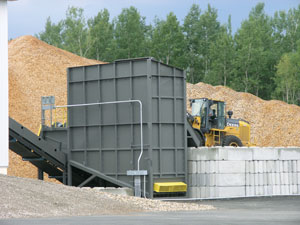 |
|
| A John Deere wheel loader puts green chips into a hopper feeding the first Andritz Sprout hammer mill with 5/8” screens. The hammer mill is enclosed to reduce noise for local residents.
|
“We could see where the local pulp wood market was going, especially for the less desirable species. Here’s a case right now where I have no market at all for the chips that are sitting there, except the hardwood. I also have a tremendous inventory of tree length piled in the woods waiting for us to get running here so we can chip it. We’ll let nature suck some of the moisture out a bit while we wait. We had to find an alternative for some of our volumes like this if we were going to have a future.”
Curran, along with his brothers Tim and Lee, have owned and operated Seaway Timber Harvesting for over two decades now. It is a large bush chipping and transport company perched on the Canadian border in Massena, New York, with established roots in the state’s private forestland market and 15,000 acres of its own. Getting fibre and harvesting it has never been a major issue for the Currans. Lately, however, markets have been. A key client, Domtar’s pulp mill just over the border in Cornwall, Ontario, shut down in 2004, but even before that, currency fluctuations were wreaking havoc for a logger paid in Canadian dollars. While Domtar’s mill in Windsor, Quebec, has since become a key client for Seaway Timber Harvesting, the dramatic industry downturn over the past three years has limited other outlets.
“We’ve been looking at pellets as a way to diversify our markets for a few years now, but it’s new to us, and a big investment, so it has taken a while to get off the ground. It’s a good fit with our existing operation, and we’re big believers in the future of renewable energy in this area.”
Curran Renewable Energy is an entirely separate company owned by the three brothers, along with a 10% equity stake by the New York State Power Authority “spec fund”.
“Basically, the investment is $10 million. We financed most of it, which was an adventure in itself. It amazed us how much money disappears up front just in financing charges. We put in some money ourselves, and the spec fund matched that to $1 million and took a 10% equity position, which we have the option to buy out. You’re looking at a company with lots of debt and not so many assets.”
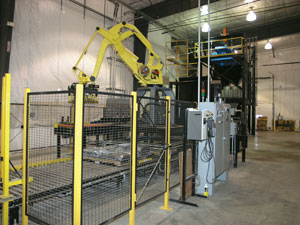 |
|
| The automated bagging line from Hamer has been designed for a quick change-over between pellets and mulch, with the latter entering via an outside infeed system.
|
|
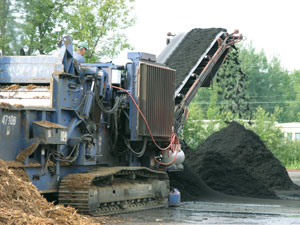 |
|
| A Peterson 4710B grinder with colouring unit works at Seaway Timber Harvesting’s main yard. The pellet mill’s bagging line has been designed to handle mulch as well, giving access to new markets.
|
Location, location, location
In fact, the Currans are sitting on a few key assets, albeit not the kind you can slide into a balance sheet. First, they have transportation and chipping infrastructure established that allows them to bring the fibre in at as low a cost as anyone. That includes seasoned crews and relationships with area landowners. They are also integrating the pellet fibre operation with an established forest products operation and markets.
“Our relationship with Domtar Windsor is key. They have been a big factor in our survival over the past few years, and we won’t do anything to risk that. We will do what it takes to meet our fibre commitments there. But our crews have extra capacity right now in this market, and so we can use that to feed the pellet plant. That means that making pellets from green wood makes sense to us where it may not to others.”
Finally, the operation is sitting on the doorstep of one of the most vibrant residential pellet heating markets in North America. As far back as July 2008, shortages of wood pellets for the coming winter became front-page news in newspapers from Maine to New Hampshire and Massachusetts. As a result, Curran Renewable Energy has built its plant with these regional residential and small commercial markets in mind.
The plant itself has been built in Massena’s industrial park right on the edge of town. It sits alongside a rail line, and future plans may well include a spur if an industrial bulk market develops.
“That’s what we hope, to give us a mix of the two markets, but for now the focus will be on the market for bagged pellets, including local sales right from the plant. We don’t expect to move a lot of pellets locally, since the population just isn’t here. On the other hand we’ll be moving a lot of trucks through town to get here, so it’d be nice to offer the local market a consistent supply of pellets in return.”
Unlimited Design
As a logging and chipping company with very little manufacturing expertise, Curran Renewable Energy turned to outside help for plant design and equipment selection. Still, the process was not without early hiccups Curran says, admitting that his eagerness to get going almost cost the young company. Fortunately the curious mechanic and logger in Pat came out just at the right time and allowed for a timely change of direction.
“At one point we were set to buy a used drum dryer from the southern United States, and just to be sure, I went to a local hardware store and bought a wrench set to open it up and have a look. It was warped like a banana inside. So I called John Lundell at Energy Unlimited to ask about fixing it, and when we went through all the costs of pulling it out, shipping and repairing it, it made more sense to buy new. At that point I started checking some of what I had been told, and pretty soon after, John was handling the project.”
Energy Unlimited eventually assumed close to a turnkey relationship, providing design and equipment selection advice, handling mechanical installation and start-up, and even supplying much of the conveying and drying gear. The mill handled site prep and concrete work for the plant that will target 100 tons per year.
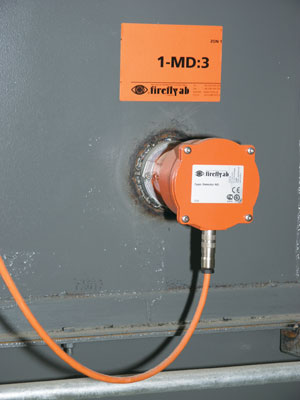 |
|
| “The first thing John (John Lundell of Energy Unlimited) asked me was where we wanted our fire,” Pat Curran recalls. Fire and explosion protection has thus been given high priority, with a Firefly AB system installed front to back.
|
The process starts in the woods, where Seaway Timber’s fleet of Morbark and Peterson flail debarker/chippers turn the region’s mixed wood diet into pulp chips. “The chips coming here are identical to those we make for the pulp market, so it’s very flexible. We can send the chips to either depending on markets.” Chips are moved to either Seaway Timber’s reload yard in Chateauguay, New York, for shipment to Windsor in Manac trailers loaded for heavier Canadian weights, or to the pellet mill. Bark goes to Seaway’s garage and office site in Massena, where a Peterson 4710B with colouring system makes landscape mulch.
Once the chips hit the pellet mill yard, the incoming vans are weighed on scales re-purposed from a company gravel pit and then go to a Columbia tipper. From here a Cat wheel loader feeds a hopper bought used from the shuttered Domtar mill in Cornwall. “Aside from this piece of used equipment, it’s all new gear,” Curran adds.
The hopper feeds the first hammer mill, an Andritz Sprout model with 5/8" screens contained in a stand-alone building. “We’re right in town at this location, so we’ve done what we can to try to isolate the noise,” he explains.
This fibre then goes to a 13 x 16 foot Baker Roman triple pass rotary dryer supplied by Energy Unlimited along with one of the supplier’s own burner units. From the dryer, fibre is conveyed to cyclones, passing through the first of a series of Firefly AB spark detection sensors. Spark detection and fire mitigation has been an emphasis at the plant since day one.
“One of the first things John (Lundell) asked me was ‘where do you want your fire’. So we designed to handle that possibility throughout the plant. The detection system we put in was a little more expensive than others we looked at, but we felt it covered more in the plant.”
The Firefly system gives the plant full coverage, starting with sensors between the dryer and cyclones and ending just ahead of the bagging storage silos. To avoid false alarms, the sensors are insensitive to daylight. Yet to make sure all potential risks are managed, the infrared sensors pick up both “dark” embers (those between 250 and 700 degrees Celsius that can still ignite the dry meal) and what we more traditionally think of as sparks (above 400 degrees Celsius). If an incident occurs, the system uses a full-cone spray that is able to handle the high-volume flows typical of pellet mill conveying systems.
Fibre is sent from the cyclones to the second hammer mill, another Andritz Sprout model with 1/4" or less screens. From this point the meal goes either to a bag house to feed the pellet mills or to the burner to heat the dryer. For start up, the plant brought in some animal bedding to fuel the burner, an exercise that gave Curran Renewable Energy other ideas.
“We’ve left a spot for a shaving line just outside the dryer,” Curran says. “We wanted to have an outlet for our dry meal if our pellet inventories ever get too high, and animal bedding is a good market here. But we saw that the bedding we were buying was actually very close in quality to the meal we’ll be making pellets with, so we hope we can avoid putting a shaver in altogether.”
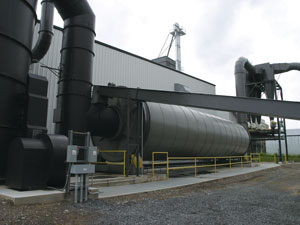 |
|
| Energy Unlimited’s original role was to install the burner and triple-pass rotary dryer, but the company ended up managing the design, mechanical, and start up for the whole project.
|
|
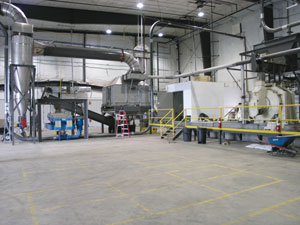 |
|
| The plant design includes three Andritz Sprout pellet mills, with room for a fourth should it be needed. The pellets go to a MilPro (Law-Marot) cooling system, Andritz shaker screen, and then to the silos. The plant is designed to make pellets on a 24/7 basis.
|
Once inside the main building, pellets are made by three Andritz Sprout pellet mills. Room has also been left for a fourth down the road if needed. Pellets go to a MilPro cooling system from Quebec’s Law-Marot, through an Andritz Sprout shaker screen and then are sent across the yard to a solitary agricultural-style storage silo from Kramer Metal Products. Again, the designers left room for a second silo down the road if cash flow allows.
Throughout the process, the plant maintains two distinct fibre sources, allowing the Currans to offer its clients Forest Stewardship Council (FSC) certified pellets. “Whether it helps us time will tell, but I believe it will. Unlike lumber that gets covered up, people will be accessing their pellets for heating daily or weekly, and they’ll see that label. We’re getting enquiries already, so I think it will be a factor for us down the road.”
Pellets are bagged on an automated line from US supplier Hamer Inc., including a robotic palletizer and a plastic wrap turntable. “We have some work to do on the latter to make the packages more windproof. We want the pellets to be completely protected before they get to the consumer, and the system isn’t doing the job we want as of yet. We’re adding a cover ourselves for now.”
The line was also designed on rails so that it can be slid back several feet to allow the plant to bag mulch as well. Mulch is brought in via an outside infeed, bagged, and then follows the line just as pellets would.
“We figure we can bag all our pellets on a 24/7 operation in just eight hours on this line, so we’ll have time to bag the mulch too. We’ve been in the coloured mulch market for years, but this allows us to bag the product and sell into different markets. It will also allow us to back an inventory ahead of winter, so that when the garden centres start looking for bags in the early spring we’re not struggling with piles of frozen mulch.”
Changeover takes less than an hour, but in future they are hoping to add extra pellet storage silo capacity so they can run pellets for a full week before switching.
“So far the line runs well. We’ve done 20 bags per minute with mulch and we know with pellets it will go easier.”
Pellet inventory will be stored inside the rest of the 30,000 square foot building ahead of shipping. The company has also added four new Manac flatbeds to handle some of its own distribution. In the end, Curran feels that becoming a reliable, consistent heating supplier will be crucial to growing the wood pellet business in general.
“There is already interest and demand for wood pellets for heating in this part of the country, but regardless of what anyone thinks, we need a surplus to make this market work; not a glut, but a surplus. And for us that means everything from the fibre to delivery. Our focus starts on the fibre, and we believe that access to fibre will be a big factor going forward. Customers will be relying on me, and just like our traditional logging operations, some kind of inventory will be important to handle the surprises.”
And from what he’s seen of pellet manufacturing, surprises will not be unheard of. The mill originally hoped to start running in January, but a series of delays eventually pushed things back to late June. Curran says it’s not like they’ve been trying to make pellets since then, just fine tuning the design and dealing with unexpected delays.
“We’ve been working the kinks out of the flow, but just parts inventory has been a learning curve. We know what we need on hand to keep the chipping business running after all these years, but we haven’t built up a similar must-have inventory here yet. We had a faulty 500-hp motor go down on one of the hammer mills that cost us two days, and then no sooner did we fix that than a 1-hp motor failure cost us another two. As soon as cash-flow allows, we’ll be stocking critical items like that.”
Yet already the Currans have done what many logging operations in Canada have only been talking about – turned a lost customer base and excess fibre into a new biomass business opportunity. •
Print this page